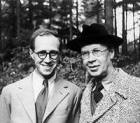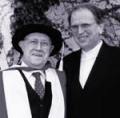
Sergei Prokofiev
Prokofiev wrote with legendary facility and surety. Sergei Eisenstein wrote of the experience of working with the composer on the film, Alexander Nevsky:
"
We view a new piece of film at night. And in the morning, a new piece of music will be ready for it.
Prokofiev works like a clock. The clock does not run fast, nor does it run slow."
Uncharacteristically, then, the piece which eventually became the Symphony-Concerto for cello and orchestra cost Prokofiev unusual time and labor.
He composed the first sketches for a Cello Concerto No. 1 in the summer of 1933, a summer he spent largely in Paris. The composer often worked on a number of projects in parallel; but in the case of the Cello Concerto, his Muse was unusually coy. He would complete a second Violin Concerto three years before the Cello Concerto's premiere in Moscow on 26 November 1938.
Of the ultimate piece, cellist Alexander Ivashkin notes in this cd booklet, "
The Symphony-Concerto is indeed extremely difficult for the cello, but it is never impossible (as was the case with Cello Concerto No. 1)." The impossibility of the solo part did not overawe the young Mstislav Rostropovich, however, who played the concerto in December of 1947, in the Small Hall of the Moscow Conservatory; when the composer went backstage afterwards, he promised the cellist to rewrite the concerto for him.

Rostropovich and Prokofiev
Slava spent some time at the Prokofiev dacha for four successive summers; at last, a piece so utterly re-worked, that Prokofiev dubbed it Cello Concerto No. 2, received its premiere in Moscow on 18 February 1952, with Sviatoslav Richter conducting.
In rehearsal, members of the orchestra ridiculed the solo part as unplayable and dissonant. With Rostropovich as consultant, Prokofiev probably did not commit to paper what he was not confident that the cellist could execute; but there are numerous quadruple-stops (the cellist playing all four strings at once), often in rapid succession; some passages of the formidable cadenzas are notated on two staves; and there are many rapid figurations high (for the cello) on the treble clef. Still, following this performance Prokofiev made considerable changes in the orchestration, recomposed the third movement, and then definitively re-titled the work Symphony-Concerto. In this final form, the piece would not be performed in public until after the composer's passing, on 5 March 1953 (ironically, the same day that Stalin died).
The recomposition of the third movement is an amusing tale. In 1948, the (deservedly) unknown Soviet composer Vladimir Zakharov offered the opinion that Prokofiev had no melodic talent. When Prokofiev re-worked the third movement, he exchanged a series of variations on a Zakharov song, "
Bud'te zdorovy, zhivite bogato (Be healthy, live richly)" for one of the interior episodes.
The character and breadth of the piece itself, argue for the unusual title (which is Symphony-Concerto, and not Sinfonia concertante with its implications of Mozartean delicacy and classical restraint). In length (40 minutes), it is not much briefer than both the violin concerti put together. Considered as a Symphony, this is a piece which departs more freely from the 'symphony mold' than was quite approved by the Proletkult (in 1948, Prokofiev had been censured for his Symphony No. 6, whose most obvious features are its three-movement cast, and insufficient cheerfulness). In contrast the Symphony No. 7 fits neatly the classic four-movement model, and is beguilingly transparent "But is not the music too simple?" he pressed his colleagues; yet the fact is that Prokofiev wrote convincingly, regardless of where any given piece registers on the density scale.
Closer in spirit to his other concerti than to the later symphonies, the Symphony-Concerto is richly episodic; the overall design is clear enough, yet each succeeding passage has an air of novel discovery to it. Apart from its symphonic scope, the piece is a departure from the concerto tradition in overall plan; instead of the usual fast-slow-fast scheme, Prokofiev wrote a central Allegro giusto (at nearly 18 minutes, the dominant movement) flanked by two Andantes.

Rostropovich and Ivashkin
The first movement opens with a fortissimo statement of a simple la-ti-do-mi ostinato (the same figure which, more hushed, accompanies "Juliet alone", in No. 47 of Romeo & Juliet). The first and second movements have extended passages in Prokofiev's lyrical vein. The third movement begins with a curiously Mendelssohnian chord, and the soloist declaims Prokofiev's theme, which then undergoes some rhythmic transformation; a brief developmental episode begins to introduce fragments of the Zakharov "Bud'te zdorovy" as a motivic outgrowth of Prokofiev's tune. Its complete initial statement is entrusted to the bassoon; the tune is passed to the soloist in double-stops, then to a sextet of soli strings, in a charmingly archaic intrusion. Prokofiev's theme returns in a modified recapitulation, and then there is a magical transformation of the theme, with eighth-notes sparkling in the celesta against the soloist.
Paris in the early 1920s flirted with artistic implications of the Machine Age. Then it was that expatriate American George Antheil scored a Ballet mécanique for eight pianos, pianola, four xylophones, two electric bells, two propellers, tam-tam, four bass drums and siren. Swiss composer Arthur Honegger enjoyed his greatest single success, perhaps, with his "allegory in speed," Pacific 231, which used an orchestra of more traditional make-up to imitate a locomotive.
In his first symphony, Prokofiev had nodded towards the august tradition of Haydn; and for his next, he wanted nothing to do with the 'dead hand' of Glazunov, as he rebuked his friend Myaskovsky for his latest symphonic work. Prokofiev found some fascination in the style mécanique, though he was not completely intoxicated by it; he coolly evaluated Honegger's locomotive as "insignificant in content but very tough and brilliantly orchestrated."
Very tough and brilliantly orchestrated is a perfectly apt description for the Allegro ben articolato which is the first movement of the Symphony No. 2. So dense is the scoring that, Prokofiev's focused labors notwithstanding, the orchestration was not finished until two weeks before the premiere (6 June 1925). Given such a short time for Koussevitsky and the orchestra to try to subdue so unusual a score, it is no surprise that this first performance nonplussed the audience; and the reviews, ranging from tepid to scornful, stung Prokofiev.
Walter Straram rehearsed the orchestra intensively for the second presentation of the symphony, on 26 May 1926 "If they haven't learned to love it," Prokofiev wrote Myaskovsky, "then at least now they are afraid of it."
The first challenging feature of the symphony is, it is in two movements, but lasts nearly forty minutes in total. (Strangely, the duration listed in the Boosey & Hawkes score is 25 minutes; with determined pacing, the second movement, alone, could be made to fit in at 25 minutes, but the entire symphony impossible.)
For its twelve minutes, the first movement is an unstoppable force of motoric rhythms, and seething melodic fragments. A bit surprisingly (considering its non-traditional surface), the movement is laid out as almost a routine sonata-design. Only, the theme groups are not melodies clearly exposed in a single recognizable line; the first theme group is a boiling polyphonic goulash which continues to puzzle many listeners even today. But the closing theme is marked by a relaxation in tempo, and draws to a clear cadence; the beginning of the development discloses itself honestly to the ear; the recapitulation is a clear event. Once the listener gets his bearings with these, the arrival of the second theme group in both exposition and recap becomes, well, obvious. The whole arc of the movement is a swirl of dense textures and unrelenting harmonic clashes, though supporting what is generally diatonic thematic material (in which, Prokofiev mastered the grammatical lessons from Stravinsky's
Le sacre du printemps).
Perhaps the problem in this piece's reception then was, its breadth. (And subsequently, it is one of a number of major works which it would prove impractical for Prokofiev to bring forward in the Soviet Union.) But its architecture holds together; there is a sense in which the only 'problem' with Prokofiev's piece is, that it came forty years ahead of the day when such sustained pitch density would become general practice.
The Theme and Variations of the second movement is a fusion of the traditional form, with the fragmentary approach to melodic material employed in the first movement. In the classic theme and variations, the overall form of the theme is preserved in each variation, as a framework; but Prokofiev elects to do otherwise. His theme for the second movement, in abrupt contrast to the sustained blaze of activity of the first, is a quiet melody floating above an accompaniment of serene, shimmering calm is in fact, the first long-breathed tuneful utterance of the piece. The variations take up the general principle of piecing the melody apart which characterized the first movement; each variation has its own shape, and the first through third variations form a big accelerando. Variation IV is a silken Larghetto. Subsequent variations gradually bring first the character, and then thematic material, from the first movement into juxtaposition with the varied theme; the result is a (loud) echo of the Allegro ben articolato, culminating in a full-throated passage like a huge hammer ... and then ... the theme returns, literally, without alteration save for the very last cadence. Was the violent storm only a dream? Or is this calm the dream?
Valeri Polyanski and the Russian State Symphony Orchestra are in admirable command of these two enormous, unwieldy scores; and Alexander Ivashkin's performance of the Symphony-Concerto is nothing short of breathtaking. In the Symphony-Concerto, there are a two brief passages where a background contrapuntal figure is faint in the back of the mix; and three measures where the soloist and accompaniment lose their otherwise perfect synchrony. But these are trivial flaws, in comparison to a great achievement with these two still-underappreciated masterworks.
Karl Henning
Please support Good-Music-Guide.com
by purchasing this CD using this link.

Track Listing
Sergei Prokofiev
Symphony No. 2 in D minor, Op. 40
Sinfonia Concertante for cello & orchestra in E minor, Op. 125
Alexander Ivashkin - cello
Russian State Symphony Orchestra
Valery Polyansky
Symphony No. 2, Op. 40 in D minor
- I Allegro ben articolato 12:00
- II Theme with variations 26:47
Symphony-Concerto, Op. 125 for cello and orchestra in E minor
- I Andante 11:20
- II Allegro giusto 17:55
- III Andante con moto